Menu
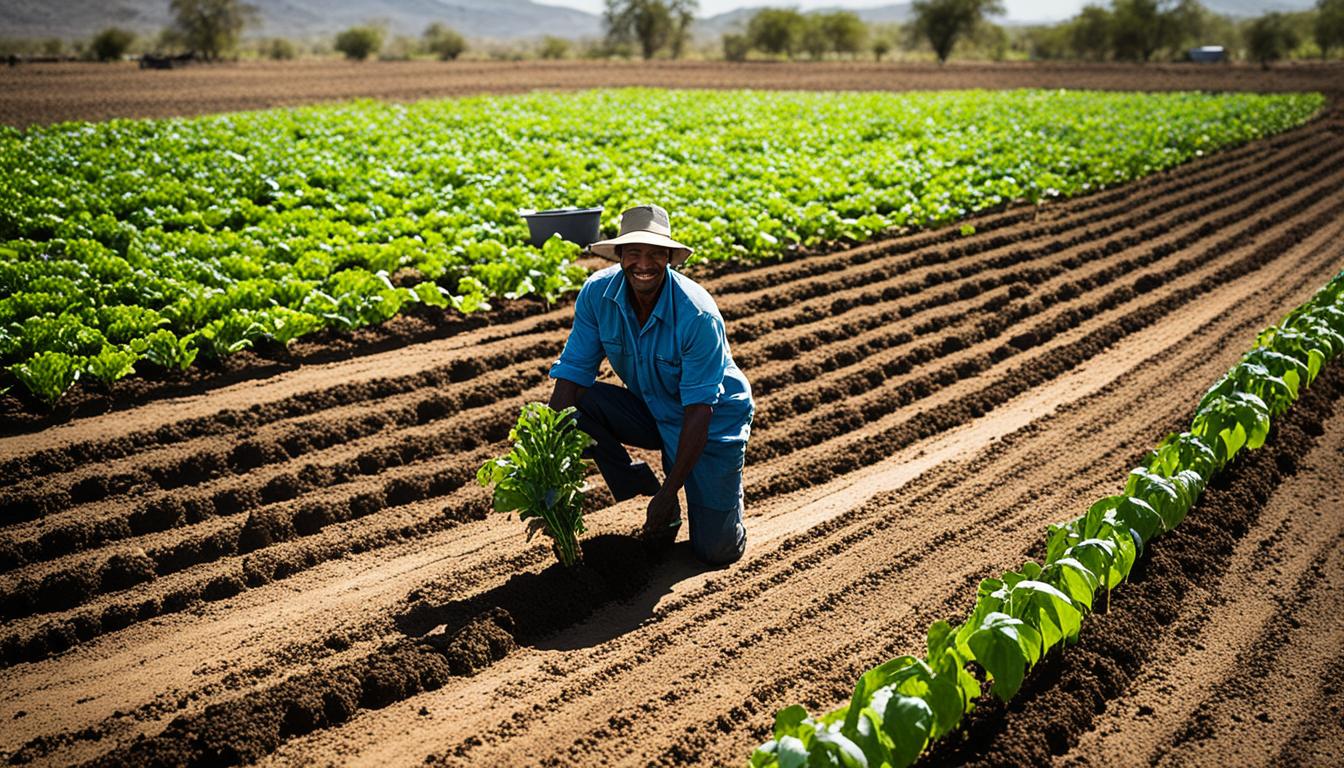
Farmers already use about half of the earth’s potential farming land. This shows how important it is to use the land we have wisely.1 Since we can’t easily get more land, we focus on managing our crops better. This includes using plants that can survive the changing weather due to climate change.
As the Earth gets warmer, farming becomes more challenging. We need new ways to keep growing food. Using sustainable methods and growing tough plants have become very important. “Using different types of crops is like having an insurance against bad weather,” says Farmer Patsy.
Climate change is shaking up farming. It’s crucial to grow plants that can thrive in unpredictable weather. Studies show that many factors, like gender and age, influence how people choose these crops as a response to climate change. Knowing these factors helps us farm better2.
With the world getting about 1.07°C hotter, farming has gotten tougher3. It’s not just about hotter days; it also means more wild swings in when and how much it rains. This brings droughts, floods, and cold snaps. So, plants that can survive these extreme conditions are really important3. A recent study found that crops that can manage with little water were high on the list of resilient qualities2.
From my experience, planting a variety of tough crops is smart. I once said, “Different types of crops act like insurance for my farm in an unpredictable climate.” This step is crucial, especially since we expect traditional crops to be less productive by 30%. “With these resilient plants, my farm stays productive and sustainable,” I highlighted.
Crop diversification is crucial in risk management farming, especially due to climate change. Growing a mix of crops helps farmers lower their risks. It guards against losses from things like severe weather and pests, as they won’t all harm the entire harvest.
This method boosts the farm’s strength and helps take care of the soil and pests too.
Diversifying crops can help solve the problems of growing just one type. Monoculture can lead to harmful pollution and less variety in nature. It also adds to the gases causing climate change4.
Having different crops can mean bigger and better harvests. This makes sure there’s enough good food to go around, helping to keep food supplies steady4.
“Every new crop is a chance to gain new skills and adjust, enhancing my farm’s ability to handle extreme weather,” Farmer Patsy said. “Planting many different types of crops is my farm’s back-up plan for wild weather changes.”
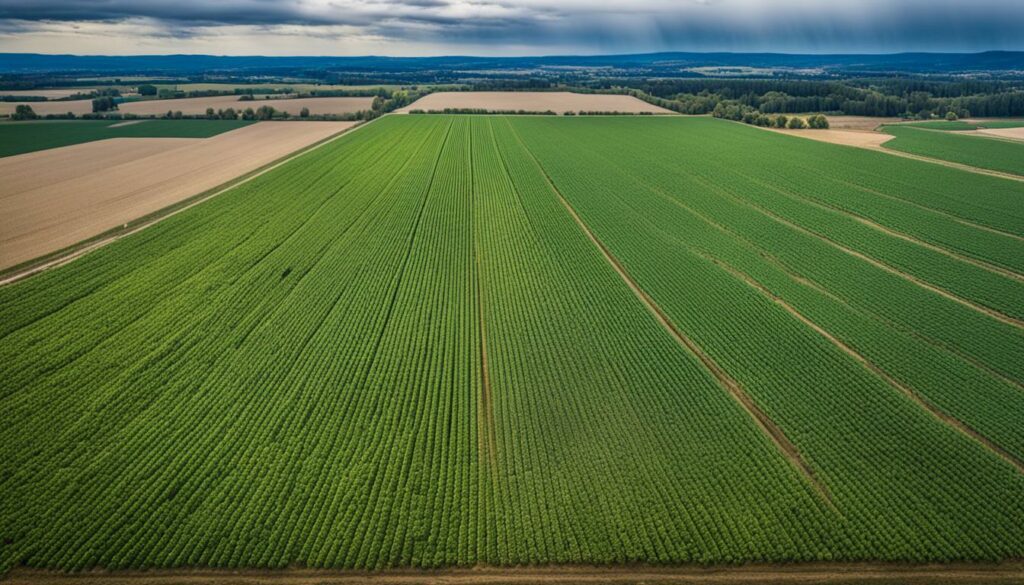
In farming today, technology changes everything. Smart farming and precision agriculture lead this change. They help us farm smarter, making it better for the planet. These new ways of farming also help with the problems of climate change.
Precision farming uses GPS, drones, and data to make the most of our resources. It helps farms produce more food while wasting less. For example, by knowing exactly what each part of the field needs, farmers can spend resources wisely.
This way of farming is not only about producing more. It’s also about doing so in a way that doesn’t harm the earth. With land for farming shrinking, we must use what we have wisely1. Precision farming makes this possible, allowing farms to be efficient and eco-friendly.
Using data helps farmers make smart choices for their crops. They gather information from sensors and satellites to understand the farm better. This info helps them predict how well crops will do and deal with bad weather.
For instance, data analytics can warn about pests or lack of nutrients before they hurt the crops. Acting early saves the plants. I use these insights to protect my farm from unexpected weather. Combining data with precision farming makes us ready for anything.
“Embracing technological advancements in farming is not just about surviving the present challenges but thriving in the future. Precision agriculture and smart farming technology equip farmers with the tools to make their practices more efficient, sustainable, and resilient.” – Farmer Patsy
So, it’s vital for farms to use tools like precision and smart farming. They help us deal with challenges and grow sustainably. And they’re essential for feeding more people without hurting the planet.
Sustainability in agriculture is key, using methods like conservation tillage. This technique reduces soil disturbance, helps cut erosion, and boosts soil health. It’s all about protecting the earth and making better use of water1.
Another important approach is crop rotation and cover cropping. These methods help with pests and enrich the soil naturally. Cover cropping not only keeps the soil healthy but also helps environment by increasing carbon storage and supporting diverse life5.
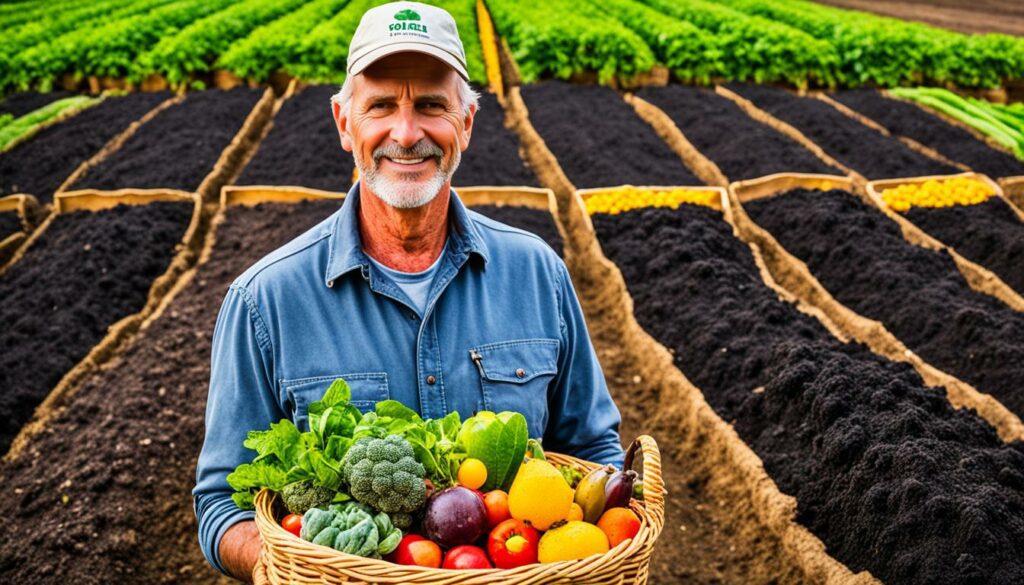
At my farm, these changes have made us ready for the challenges of a changing climate. I believe in using methods like conservation tillage and focusing on biodiversity. They make our farm strong against the unknowns of the future. It’s about a long-lasting commitment to farming wisely and being ready for whatever comes.
Handling water well is key in facing climate change’s water challenges. With efficient water management, farmers can keep their lands productive and sustainable.
Drip irrigation and similar advanced systems are vital. They directly water plant roots, cutting waste. They’re crucial for dealing with climate change and managing water better.
Patsy notes, “My advanced irrigation systems help me save water. This keeps my crops healthy, even in dry times.”
Rainwater harvesting is important for efficient water management. It saves water from wet times for use when it’s dry. Using soil moisture sensors helps farmers water more precisely6.
Below is a comparison of old and new irrigation ways:
| Parameter | Traditional Irrigation | Modern Irrigation |
|---|---|---|
| Water Use Efficiency | Low | High |
| Water Wastage | High | Minimal |
| Operational Cost | Low | Variable |
| Initial Investment | Minimal | Moderate to High |
Efforts in securing water for farms have helped places like the Caribbean. They’ve improved water use in farming, a big part of the local economy. And, better water management supports both long-term planning and small farmers7.
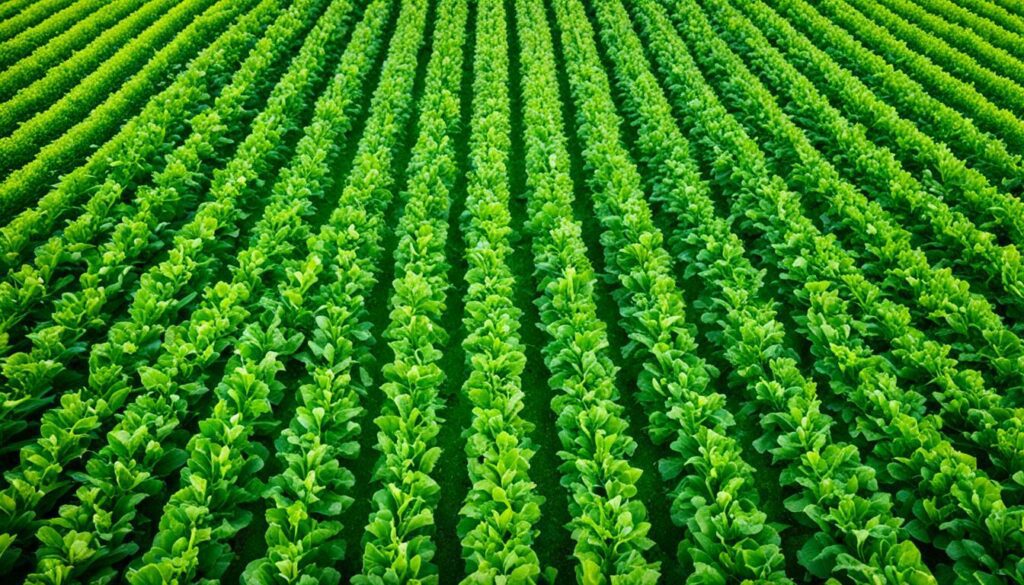
It’s important to think about how people’s background affects crop choices. Social factors like gender and age influence the use of climate-ready crops2. Addressing these differences in help and advice can make advanced farming methods more popular.
Now, let’s look at why high-yield crops and mixed planting are so good:
In short, choosing high-yield crops and mixed planting isn’t just about more food. It’s a way to farm that lasts, helping us deal with climate change. Together, by sharing what we know, farmers can overcome these challenges and keep our food supply steady for the future.
Developing crops that can handle climate change is very urgent. I am a farmer, and I know how important it is to use these strong crop types. They help our farms keep growing even when the weather is tough.
It’s been found that when there is more CO2 in the air, crops can make more food. But, they can only use this benefit if they get enough nutrients and water. This makes these new crop types even more important3.
I use the latest climate-resilient crop types on my farm. They’ve helped me get better harvests without needing as many chemicals. In dry times, these crops do especially well because they can survive with less water2.
This is in line with research that shows these special crops are tougher against bad weather. They don’t just survive – they can even produce more food despite the challenges3.
My farm is doing better than before because these crops need less looking after. A good breeding programme helps us be ready for any weather changes. This makes sure my farm can keep going strong, no matter what the climate throws at us. “Using the latest tough plants makes my farm stand out, even when the weather is hard,” I say.
It’s important for farmers, scientists, and leaders to work together towards this goal. With our efforts combined, we can make and spread the use of these strong crops. This will help create a farming future that is stable and fruitful for all.
Below is a table summarising the key aspects and benefits of climate-resilient crop breeding programmes:
| Programme | Focus | Benefits |
|---|---|---|
| Plant Mutation Breeding | Drought tolerance, water-use efficiency | Enhanced crop resilience, better yields |
| MutMap Technology | Salt tolerance | Accelerated breeding, specific trait development |
| Multi-Stress Factor Adaptation | Soil drought, high temperatures | Comprehensive stress resistance, sustainable adaptation |
The way we grow food is changing. So, farmers now work together more. They join farming networks to share what they know and the things they have. In these groups, people and whole communities meet to swap stories and learn about the latest farm techniques. This makes them better at coping with the world’s changing weather.
Farmers are teaming up in groups from near and far to learn from each other. They get vital stuff like weather tips and money help for their farms this way. In the US, the Natural Resources Conservation Service (NRCS) and groups like NOMAD in Europe help farmers a lot1. Then, there’s AICCRA. They’re doing big things, like a radio show in Zambia, in languages Nyanja and Bemba, that talks to 2.5 million people9.
Sharing the best ways to do things really helps farmers fight changing climate. Being part of a farming network means they can learn smart farm methods at special meetings. AICCRA even held a big meeting to make lessons about the climate for African universities9. Farmers are also sharing new and innovative ways, like using technology to grow more food.
“Engaging in these networks has transformed my farming practices and helped me stay ahead of climate-related challenges,” says Farmer Patsy. “The knowledge exchange in agriculture has proved invaluable for ensuring the sustainability and efficiency of my farm.”
By always learning and teaching, farmers stay up to date with the best farm ways. Many policies and help from around the world push for farms to be sustainable. This tells us how working together and helping each other build stronger farms is very important.
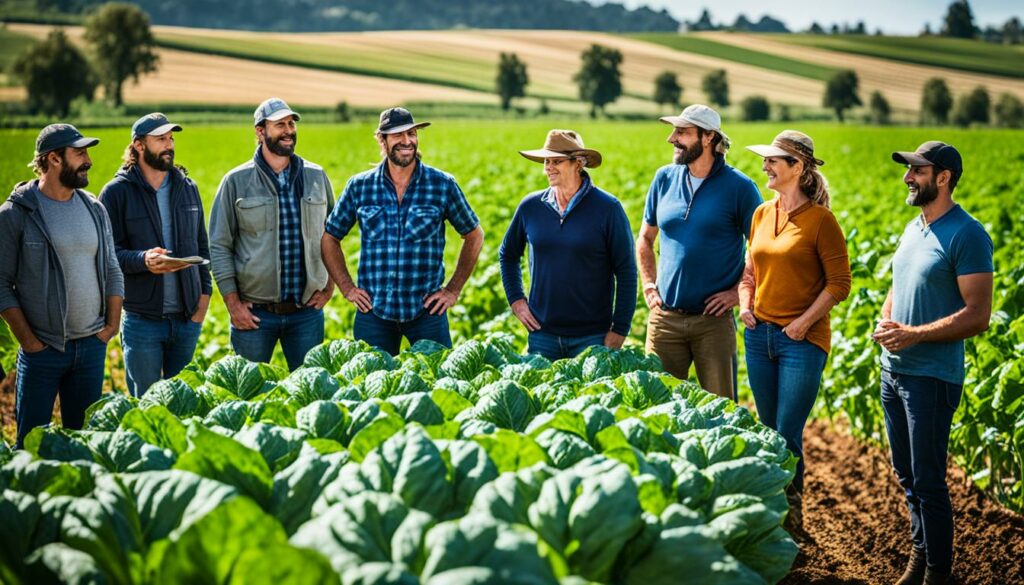
We can see how vital these network and knowledge sharing are by looking at big programmes worldwide:
| Country/Organisation | Program/Initiative | Focus |
|---|---|---|
| United States | Natural Resources Conservation Service (NRCS) | Support for adopting sustainable practices and recovery from weather-related losses |
| European Union | NOMAD | Sustainable agriculture development |
| AICCRA | Radio Program in Zambia | Reaching 2.5 million listeners with agricultural innovations |
| African Union Commission | Climate Action Innovators Hub | Fostering innovation in climate-smart agriculture |
All this shows the big support for farmers. By getting involved, farmers can use smarter ways and strong practices, making farms last and grow more.
Today, knowing the weather well is key for farming success. About 90% of farms understand how bad weather can hurt their crops. This shows why getting the weather right is so important10. Also, over a third of farms find it hard to guess what the weather will do. This makes how much they grow change a lot10.
Benchmark Labs stands out with their weather tools. Farmers using their system save water and grow more. They report using 10% less water and raising their crop production by half or even twice as much10. These improvements are a big deal, especially because Benchmark Labs’ forecasts are up to 84% more accurate than the usual ones in the US10.
Farmer Patsy says, “Knowing the weather in real-time changed how I farm. It lets me avoid risks and make smarter choices.”
Good weather predictions help farmers in many ways. They make managing work, water, and pesticides easier. This leads to better crops and less harm to the environment10.
Plus, now farmers can get weather updates every hour online or through apps. This helps them act quickly and wisely, saving their crops from bad weather10.
Weather guesses have become more detailed and useful. Many special crop farmers think better forecasts would directly lift their crop quality. With millions of sensors worldwide, there’s huge potential for even better and more helpful info for farmers10.
Farmer Patsy highlights the tools’ big role, saying, “Good weather predictions are now a must in dealing with climate change. They’re like a guide that keeps us ahead of surprises.”
Farmers are focusing more on building strong, climate-resilient infrastructure. This helps protect their farms from sudden and unpredictable weather. They are designing and building farm structures able to endure harsh weather. Also, these structures use smart design to adjust to changing conditions.
The need to build buildings that can face tough weather conditions is growing. FEMA’s BRIC program is providing $1 billion in FY 2023 to help with this cause11. The goal is to make sure farm buildings stay strong even during the worst conditions.
This money can be used in various ways, such as helping specific states or tribes. It also allows for national-level projects to apply for support11.
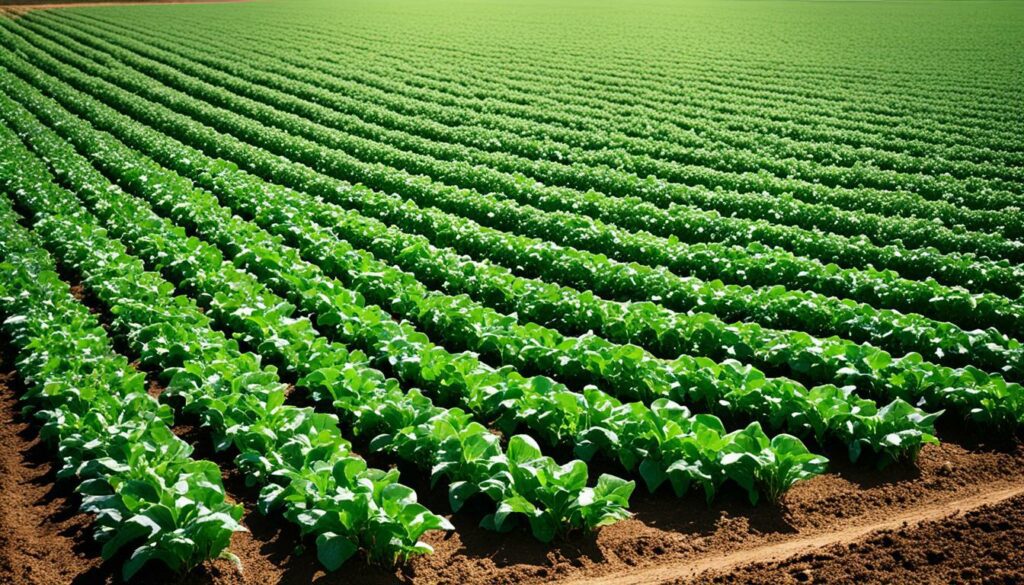
Good information and tools are key for making good climate-risk choices when building. By making infrastructure that can handle climate issues, we make everything last longer. This approach also ensures that the services provided stay reliable, and that the assets are well-cared for12. A solid infrastructure plan finds the best ways to make everything work together to increase resilience.
Natural features, like windbreaks, are very important in smart farm design. They protect the farm from harmful effects and support a wide range of plants and animals. This two-in-one effect helps with climate adaptation and takes care of the environment. FEMA’s Justice40 Initiative aims to help the most in-need areas. They do this by carefully choosing which projects to support, making sure everyone gets a fair chance11.
Public policies that focus on climate resilience help even more. They make sure that climate-smart choices are considered when buying things for the public12.
OECD shows that a large part of flood damages can hit our infrastructure. So, we really need to focus on making our buildings strong12. The success of the BRIC program proves that investing smartly in resilience works. Submissions from poorer rural areas grew by 15%. This shows they are doing better thanks to these efforts11.
“Incorporating windbreaks and other natural features into farm design not only shields my crops from harsh winds but supports a diverse ecosystem, making my farm more resilient and sustainable in the long run.” – Farmer Patsy
Building climate-resilient farm structures and using smart design are key steps. These efforts help ensure our farms keep working well despite the changing climate. The support and expertise from programs like BRIC help farmers create structures that can thrive under tough conditions.
Learning never stops, especially for farmers facing ongoing climate changes. We must take part in workshops and classes to learn new skills. These help us change and do well despite the challenges.
These workshops are key to teaching farmers how to be smart about climate change. They cover many areas, like ways to farm that help the earth and using new tech to make farms stronger. Up to now, half of the world’s land where plants grow is used for farming. Farmers need to use this space wisely. They do this by swapping which crops they plant and choosing kinds that give lots of food in a small area1.
Learning a lot about farming is important. It keeps us up to date with new ways of doing things. When we know more, we can face the hard parts of climate change better. Farmer Patsy believes that every new thing we learn makes our farms stronger against bad weather.
The ASEAN Guidelines for Agroforestry Development and the Training Manual: Agroforestry for Climate-Resilient Landscapes help a lot with learning about farming. They are important for farmers trying to take care of the land better13.
The help from governments is also crucial. They give money and help with technical things. This support makes it easier for us to learn how to farm in a way that’s good for the planet1.
Agriculture-focused climate policies are key in how the sector responds to climate change. Around the world, governments are putting in place measures. These actions help farmers use sustainable methods and get help during bad weather. For example, a project in Kenya, supported by the World Bank, helped over 60,000 farmers. Half of these were women. Such steps not just increase output but also improve fairness in agriculture.
Getting research funds and laws is vital for preparing for climate change. In the United States, farming makes up about 10-11% of all the greenhouse gases. I know from my own work how important it is to have government schemes that cut these emissions. For instance, backing the use of precise farming methods has cut down harmful nitrogen. This makes farming greener and better able to cope with climate change.
Governments are also key in financing studies on how farming affects nature. In Madagascar, there’s a project to help farmers cope with more unpredictable rains. This is from changes in the climate. It’s crucial for local authorities to set up groups that plan for how to handle the effects of climate change. This can be seen in Kenya’s Isiolo and Kitui Counties. They help with money for local projects to deal with droughts14.
In my farming expertise, I see the value of government aid. Things like funding for new irrigation tech and for growing crops that can withstand the changing climate are very helpful. Also, pushing for farmers to grow different crops and always learn new things makes a big difference. These efforts help farmers be ready for the tough weather conditions brought on by climate change.
Rising temperatures and unpredictable weather affect farming. This leads to more pests, changing water patterns, and challenges in growing food. We must find new ways, like special crops and careful farming, to keep producing food.
Special crops can handle extreme weather and diseases. They keep farms productive even under tough conditions. This is crucial for food’s future security.
Planting different types of crops reduces the risk of a total loss. It also keeps the soil healthy and helps fight off pests and diseases. This makes farming more flexible and strong.
Precision farming uses GPS, drones, and data to farm smarter. It helps farmers use resources better with less waste. This means farms can cope better with changing climates.
Methods like not ploughing all the land, swapping the crops each year, and planting temporary crops help the Earth. They use water better and help support more plants and animals. This makes our farms stronger in the face of change.
Drip irrigation, sensors for moisture, and saving rainwater all help save water. Knowing how to best use water means farms can keep going even when it’s dry. This is key to growing food in the long run.
High-yield crops produce lots of food without using too much space. They help the land stay healthy and support more wildlife. This way of farming is good for both people and the planet.
By breeding strong plants, we get more food without using lots of chemicals. These plants are tough and still give good crops. It makes farming both smart and strong against the changing climate.
Being part of farming groups lets farmers learn from each other around the world. They share new ideas and help each other. This makes all farms more ready for surprises in the weather.
Knowing the weather in advance lets farmers plan carefully. It’s like a warning system that helps avoid big losses. This is very important for safe and smart farming.
Building strong farm structures and using natural features can protect against severe weather. It also helps more plants and animals live on the farm. This makes the farm a stronger and more natural place.
Learning about new farming methods helps farmers stay up to date. It lets them use the latest techniques to care for the land and grow food. This is vital for farming success in the future.
Government rules and help can encourage sustainable farming. They offer money and advice when the weather is really bad. These policies also push for more research into safe farming ways. They’re key for keeping farms healthy and ready for change.